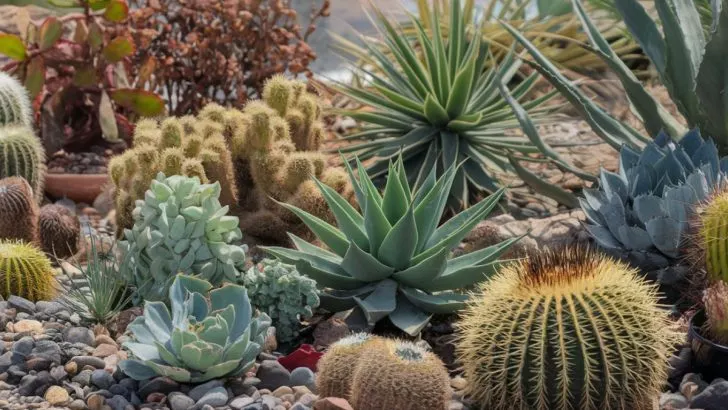Early spring isn’t so soon, but today we will talk about the low maintenance plants for Arizona you can use in your garden in this period.
This spring season will be very colorful for you since we bring you low-maintenance plants with purple flowers, dark green leaves, bright yellow flowers, and more.
I don’t know about you, but a thought of an extremely drought-tolerant plant with bright yellow flower clusters sounds pretty engaging to me.
Are you ready to “adopt” a flowering plant that is a low-maintenance plant in your yard?
If so, get ready to see lovely dark green foliage and vibrant bright colors in your yard next spring. Your desert landscape is now going to be full of flowering plants.
If you’re ready, let’s learn more about the 11 best low maintenance plants for Arizona.
Care Guide For 11 Low Maintenance Plants For Arizona
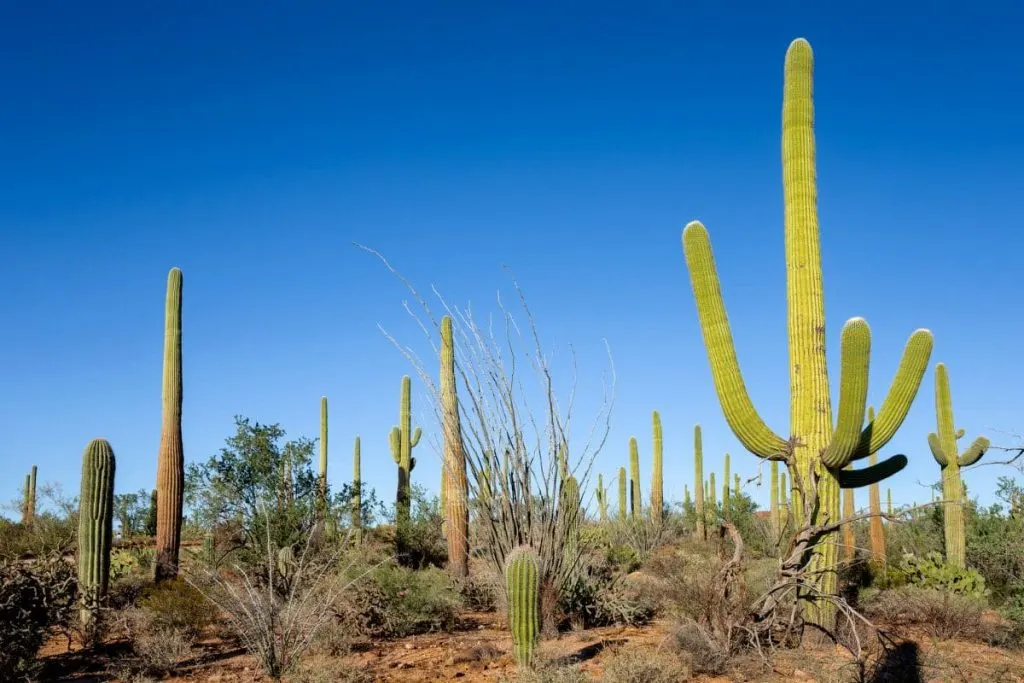
If you’re ready to have a drought-tolerant landscape, but a landscape still produces small yellow flowers in such conditions, all you need is full sun position, and I bet you already have that.
Cold hardy conditions combined with light shade and full sun will get you a garden full of vibrant colors this spring. Let’s learn more about low-maintenance desert landscape plants below.
1. Little Leaf Cordia
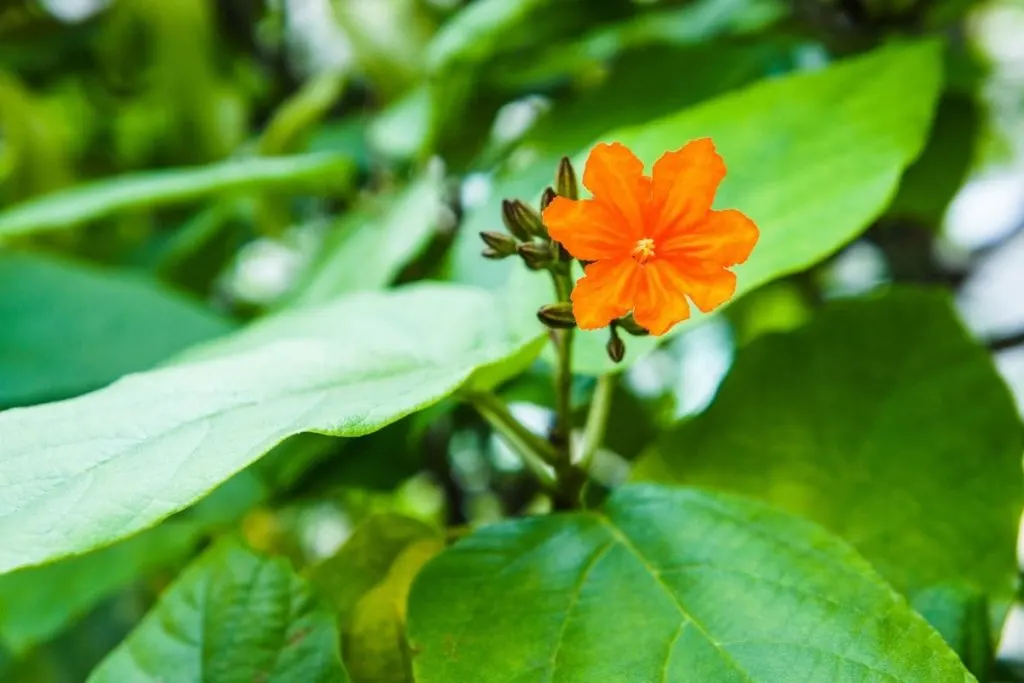
Cordia parvifolia is a well-known desert shrub. It’s a perennial plant perfect for growing in conditions of heat and much sun.
When provided with correct conditions, it can grow tall up to 12 feet. When flowering, it gets white blossoms that are just so lovely. Aside from Texas sage, these shrubs are used for visual and wind screening.
Light needs
Little leaf Cordia will thrive the best if you provide it with full sun exposure until the afternoon hours and then make sure it has a light shade and half sun in the afternoon.
Full shade position isn’t good for it, as for almost 90% of Arizona plants. They’re used to heat, sun, and high temperatures.
Water needs
The watering schedule depends on many factors such as its position, growth rate, season, soil, etc.
If you’re not using well-drained soils (well-absorbing soils) make sure you water them more since they’re growing in a desert, but if you are, once every 8 days is enough for this moderate drought-tolerant plant.
Soil type
Little leaf Cordia isn’t picky with its soil choice. They grow well in sandy soils, perlite and aridity, and alkalinity soils.
The color of its evergreen foliage depends a lot on the soil (organic matter too). If transplanting a plant in a warm season (July, August) make sure to use well-draining soils.
Humidity
Humidity is definitely a trigger for its white blossoms. Combined with desert heat during the day, your plant will just keep blooming in these arid regions.
The average humidity in Arizona is around 40% which is more than enough for this plant.
Fertilizer
A plant doesn’t need to be fertilized at any point. In its blooming season, it will still give amazing white flowers on its sprawling bray branches. They bloom in late summer to early fall.
Propagation
The best way to propagate almost all low-maintenance trees is with cuttings. Since they require very little pruning, you’ll have healthy branches for propagation when the time is right.
Make sure they follow their unique angular branching pattern with the knife when cutting to avoid damage.
Cut around 6 inches of a healthy stem and place them in the soil or water. In about 4-5 weeks you should notice progress.
2. Sugarbush
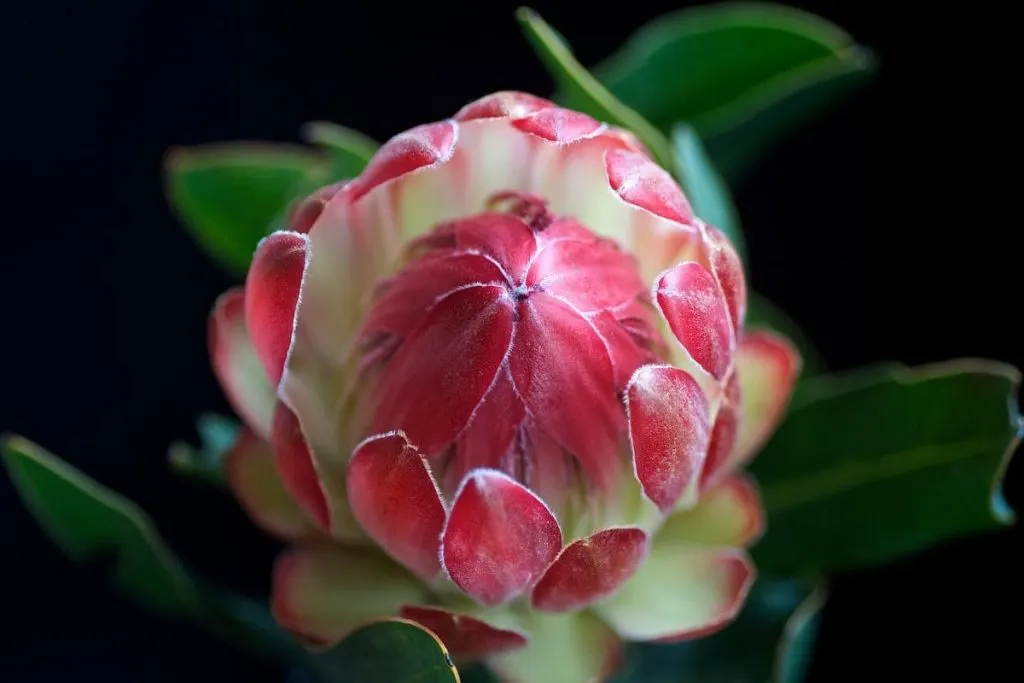
Rhus ovata is a shrub tree pretty common in the Arizona desert. They are adapted to xeriscape gardens.
They usually grow in canyons and slopes, but people grow them in gardens as well. Its flowers produce copious amounts of nectar and that is why this plant is called sugar bush.
Nectar was used to treat cough in the 18th century. Its flowers are edible.
Light needs
The best light condition for the growth of sugar bush plants in full sun and very little shade. In the complete shade, it does not grow at all and does not flower in its proper season – late spring. Its growth rate is also much slower in the shade.
Water needs
If you grow this plant in Arizona, it needs to be watered once every 7 to 8 days.
You certainly won’t go wrong with the soil assessment, but it’s always good to do a finger check even though the desert heat will do its job well in the first two days.
Soil type
The plant tolerates any type of soil and it doesn’t really matter what soil it grows in as long as the soil is well watered during the flowering season of this plant.
Most people buy soils that are high in organic matter at the beginning of planting.
Humidity
The average humidity of the Arizona desert is more than enough for this plant.
Fertilizer
Like its previous friend, the sugar bush plant does not need to be fertilized.
Propagation
It is propagated by cuttings. Cut them at an angle of 45 degrees, it is best to cut softwood cuttings.
3. Chihuahuan Sage
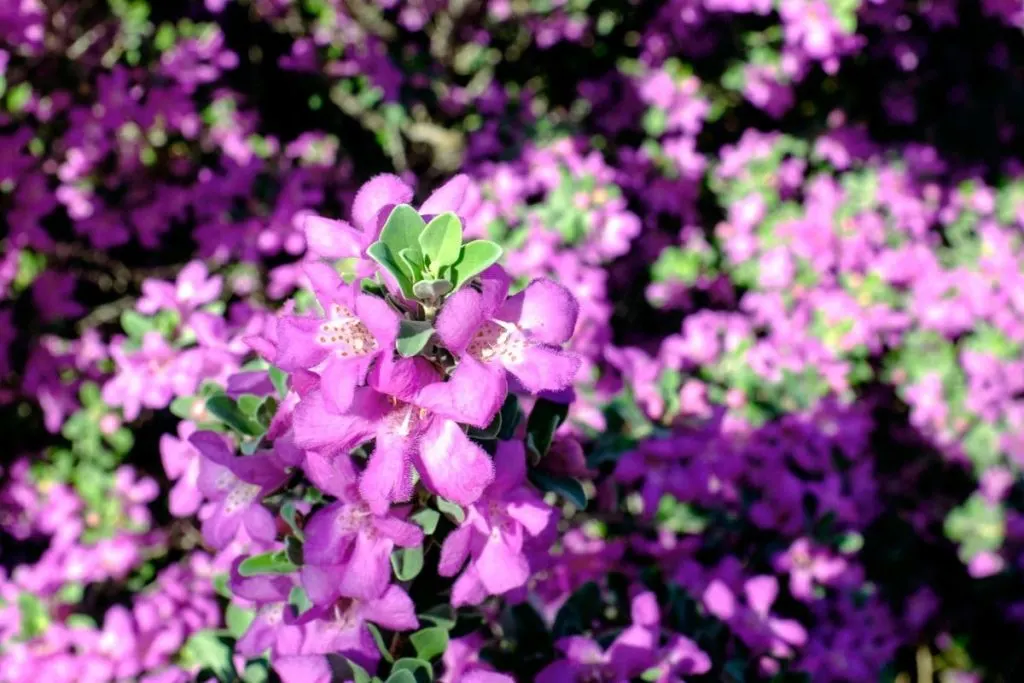
Leucophyllum laevigatum is a perfect evergreen shrub that you’ll surely want to have in a desert.
Its branches remind me a lot of lavender flowers and they have a strong fragrance. The flowers attract hummingbirds.
It has tiny leaves similar to olive leaves and they usually have a loose form.
Light needs
The plant grows the best in full sun position. Its vibrant color and height depend on the light/sun.
When growing in full sun position it can rich a height of 4 feet. They are usually one of the smaller varieties of desert plants so don’t expect them to grow higher than that.
Partial shade is tolerant, in a full shade you forget about its fast growth and bright purple color.
Water needs
Proper watering improves its flowering season, which with suitable light and adequate watering can come earlier.
Already in early spring, you can expect beautiful purple flowers with sun and water.
Soil type
The plant can grow in any type of soil, but the best soil choice is limestone-based and well-drained soil. Forget black soil, this plant does not like it.
Humidity
Average Arizona humidity is a perfect humid area for the sage plant.
Fertilizer
The plant doesn’t have to be fertilized if it’s planted in rich soils, and those we mentioned above are rich soils.
Propagation
The two most popular ways of propagation are seeds and cuttings, but a much easier way is by cuttings.
Propagation with cuttings is done the same as with the previous plants above.
4. Arizona Rosewood
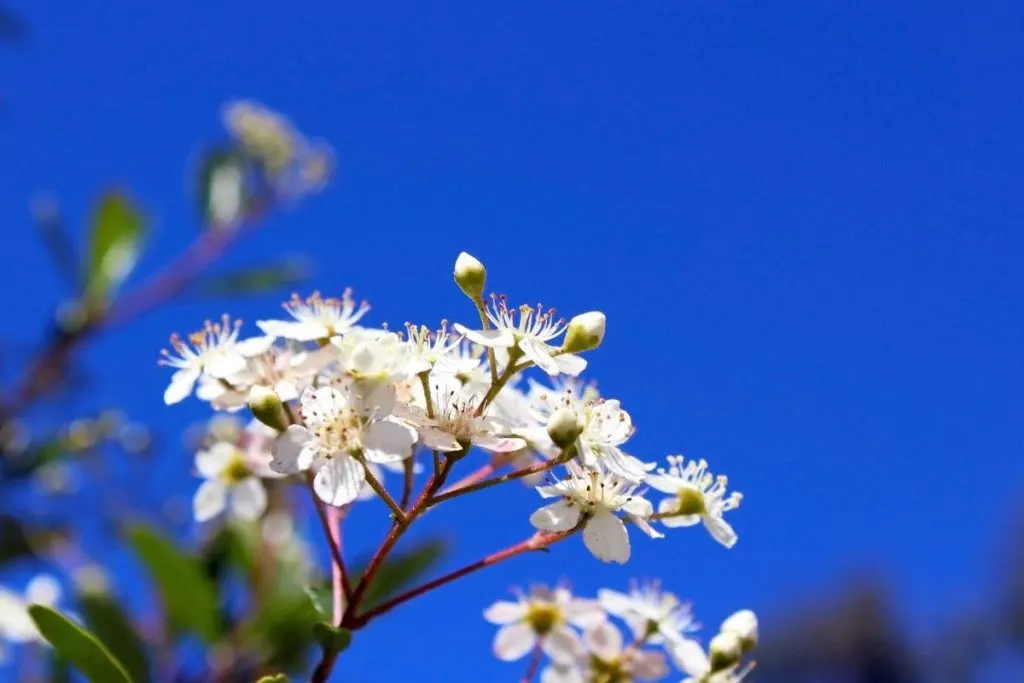
Vauquelinia californica is a perfect evergreen shrub that can grow up to 10 feet. Its yellow-green foliage will brighten up your garden.
They grow about 25 inches per year. It tolerates intense heat and much sun and it is one of the famous drought-tolerant plants.
Its leaves have a lovely attractive leathery appearance. It’s grown in Mexico as well.
Light needs
As we have already mentioned, they can tolerate large amounts of sun. Unlike the other plants above, they don’t even need partial shade.
In such sunshine, the plant will grow even better and taller and no unwanted consequences will occur.
Water needs
Watering is quite simple. Once in 10 days and you’ll be fine. Most desert plants are used to little water, and therefore have smart water reserves in their roots ready to supply the plant with that water.
Soil type
The plant can grow in any type of soil. They are not picky at all when it comes to soil, so be guided by some logic and habit when buying soil for this plant.
Humidity
Humidity is not an important factor for this plant, so the average humidity of this region suits it.
Fertilizer
Most desert plants don’t need fertilization and the Arizona rosewood is one of them.
Propagation
A popular way of propagating this plant is by seeds and very rarely by cuttings. The seeds have proven to be more effective for this plant.
5. Valentine Bush
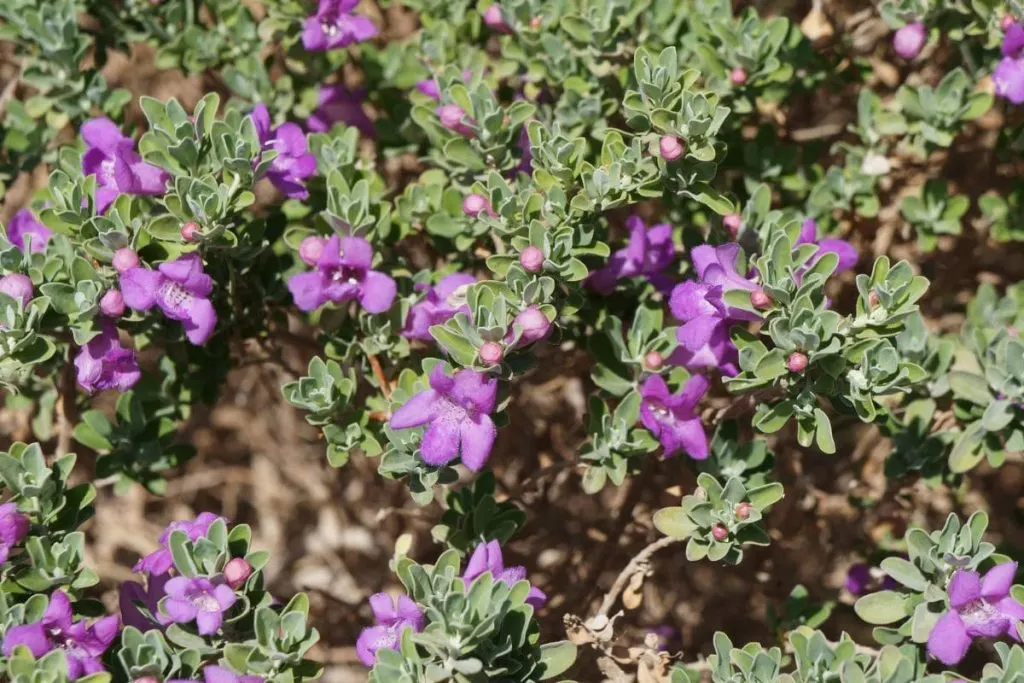
Eremophila maculata is well known for its tubular red flowers. Valentine bush is one of the most famous evergreen shrubs in the Arizona region.
You are probably wondering why is it called the valentine bush. It blooms or at least, its looms peak just around Valentine’s time. The flower doesn’t stand cold temperatures well.
Light needs
The best light condition for the Valentine bush plant is at least 6 hours of direct sunlight that you can definitely get in regions such as Arizona.
Partial shade will do good in the afternoon hours since the leaves are a bit sensitive, but avoid full shade for this plant.
Water needs
The plant is native to Australia which means that it can stand a lot of heat and a lot of sun.
Due to that information, we can conclude that it doesn’t need supplemental water during its growing season-blooming season.
Soil type
Just grow them in well-draining soils, the plant doesn’t matter what type of soil it is. They work in almost every type of soil.
Humidity
Arizona humidity is a pretty perfect humidity level for the Valentine bush plant.
Fertilizer
The valentine’s bush plant doesn’t need any fertilization.
Propagation
The easiest way to propagate this plant is by cutting that you place in water. Make sure you cut a healthy mature plant.
Once you place them in water, in about 3-4 weeks you’ll see small roots.
6. Cassia Nemophila
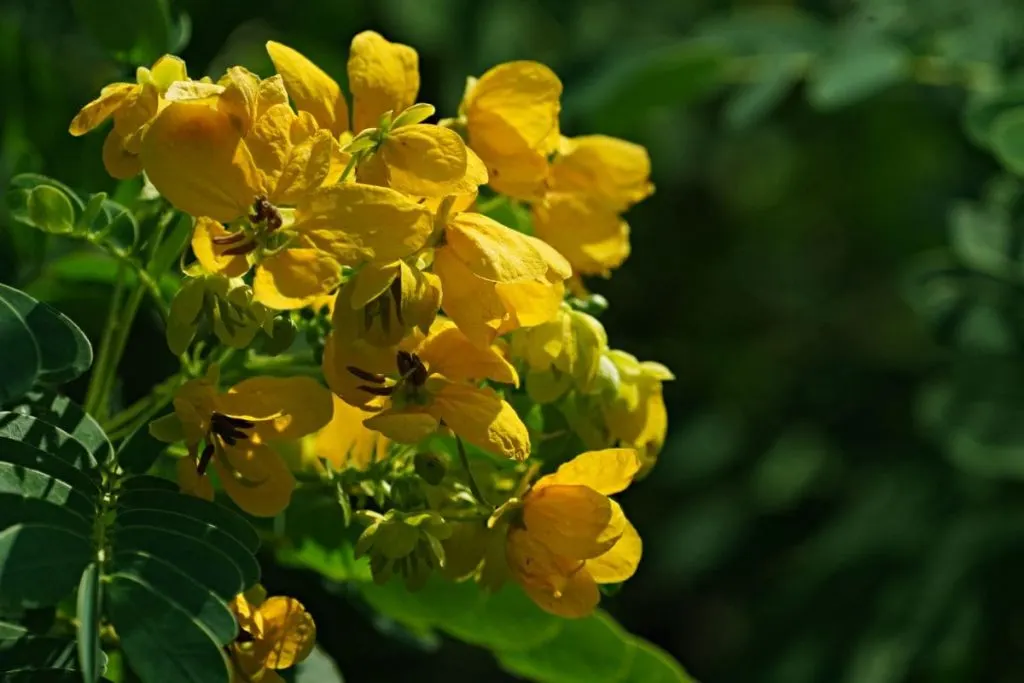
Cassia nemophilia isn’t your regular desert shrub. This is one of the plants that can be grown as a houseplant as well.
Until it starts growing faster and bigger, you can definitely have it in your home, it will grow even easier there.
The flowers aren’t seen until their maturity time, so you will be able to spot their yellow flowers once it starts growing outside.
Light needs
The plant will thrive best in a full-sun position. Even in the hottest months, don’t be afraid that the sun might burn its leaves, the plant is very heat tolerant. They don’t need much shade to “rest” their leaves.
Water needs
Water your cassia once a week and the plant will definitely benefit from it. In the hottest months don’t water it more frequently because the excess water can kill your plant too, not just the heat.
Soil type
The best soil type for cassia plants is clay soil. It is one of the best absorbing well-drained soils that will provide your plant will everything it needs.
Humidity
Average Arizona humidity works well for cassia plants.
Fertilizer
The plant doesn’t have to be fertilized.
Propagation
Propagation is done with semi-ripe cuttings and seeds. A much easier and more effective way is with semi-ripe cuttings. Propagate your plant in springtime.
7. Mexican Bird Of Paradise
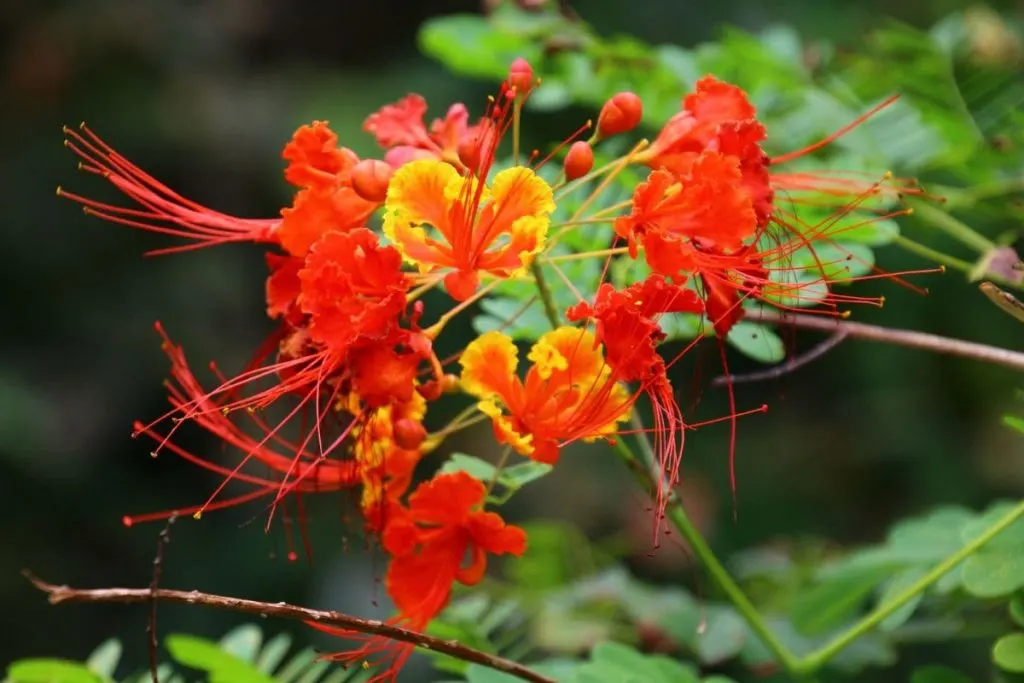
Caesalpinia pulcherrima, also known as the red bird of paradise for its vibrant red flowers is a plant native to tropical regions such as Arizona.
It’s a shrub with no thorns that can reach a height of 15 feet when taken care of correctly. It’s an evergreen shrub.
It freezes when exposed to cold temperatures so make sure you cover it up during the night when the temperatures drop.
Light needs
Even though this plant loves direct sunlight, its leaves and flowers are very sensitive, so make sure you expose them to direct sunlight for 2-3 hours only.
For the rest of the day, they should have bright light and partial shade. The morning sun is much better for this plant than the strong afternoon sunlight.
Water needs
In order for it to bloom on time and grow as expected, water the bird of paradise once a week.
This beautiful plant has other similar species, and they all have a similar watering schedule. When you notice birds of paradise leaves curling it probably means there’s an excess water problem.
Soil type
Any type of soil suits it, but this plant does not like to be in the same soil for a long time. Usually, see to it that in the spring it is transplanted into new soil that is well-drained and fertilized.
Humidity
Arizona humidity works well for it, in case of growing indoors, increase the humidity to 50%.
Fertilizer
Fertilizers that work the best for a bird of paradise are the fertilizer that has parts of nitrogen, phosphorus, and potassium.
Propagation
These plants are propagated by semi-cuttings and seeds, but easier and more effective is with cuttings.
8. Little Treasure Dwarf Columbine
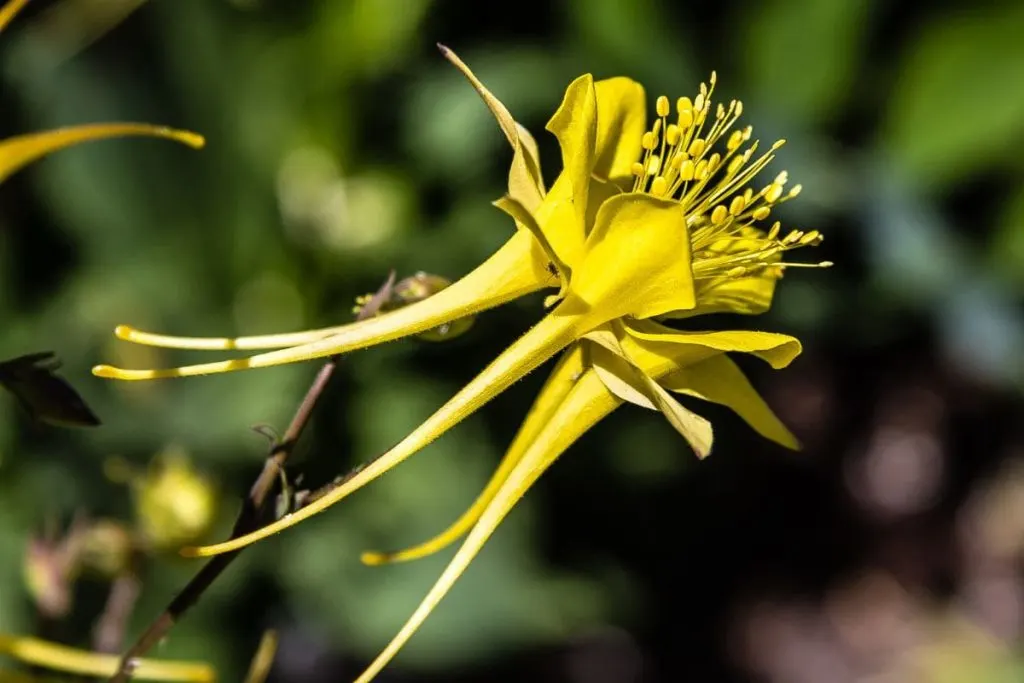
Aquilegia chrysantha v. chaplinei is one of the popular drought-tolerant plants of the Arizona region.
If you enjoy this plant, it’s more than sure that you’ll love large succulent plants that can be great houseplants, unlike the little treasure that’s more of an outdoor plant.
The plant is a perennial native to New Mexico.
Light needs
This beautiful drought-resistant plant loves the sun, so keep it in a sunny position for at least 5 hours a day to get enough solar energy for its growth.
The position would be ideal if it has an afternoon shadow, but not so strong.
Water needs
The watering schedule is very simple. Once every 8-10 days is enough for this beautiful plant to bloom. During the flowering period, you can water it every 6 days.
Soil type
They grow best in compost-enriched soils, but most of the other soils work for this plant well enough.
Humidity
Humidity should be around 50%, so in case of growing it indoors, increase the humidity with an air humidifier.
Fertilizer
Unlike most of the low maintenance plants in Arizona, this plant doesn’t have to be fertilized too.
Propagation
Propagate the little treasure dwarf plant with cuttings. All of the dwarf trees and shrubs along with flowering trees in Texas are propagated with cuttings and it’s shown as the most effective way.
9. Feathery Cassia
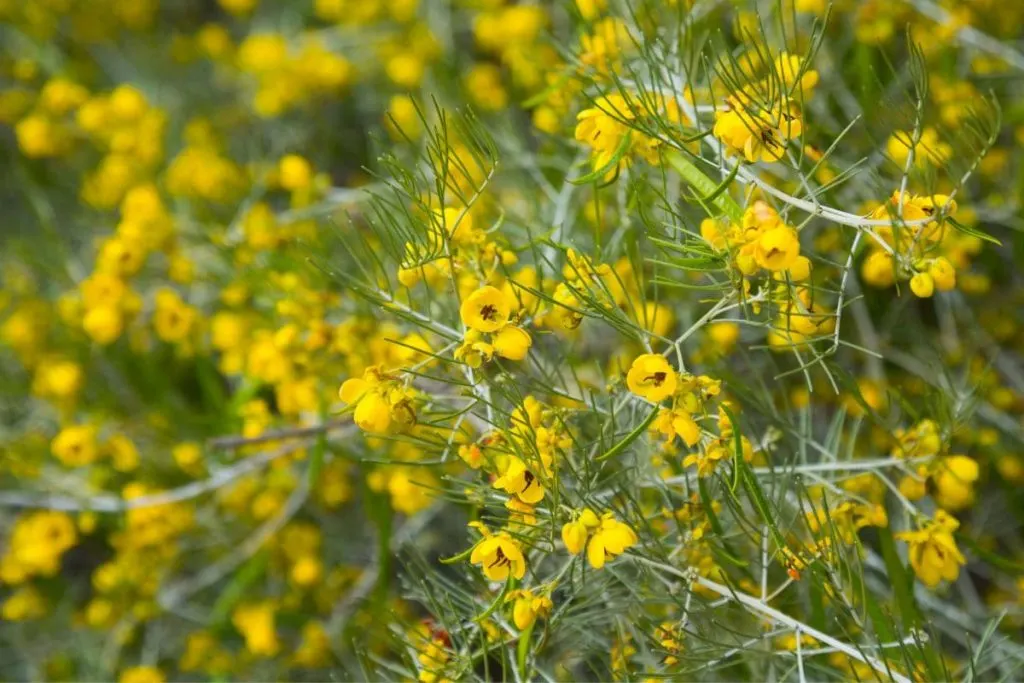
Senna artemisioides is among the most popular flowering trees yellow. Its fragrant flowers attract hummingbirds and this lovely evergreen shrub will make your garden a perfect yellow space in the spring. Its height usually reaches around 12 feet.
Light needs
The plant doesn’t need much light, but the morning sun you give to it is more than important. With about 3 hours of direct sunlight, it will bloom as it lives in the sun. However, in the blooming season, it needs more direct sunlight.
Water needs
In the wintertime, water them once a week, but in the summertime every 10 days is more than enough for this drought-tolerant plant.
Soil type
Neutral pH is all you have to pay attention to, mostly, any soil type works well for them.
Humidity
Between 40 and 50% is the best humidity ratio that works for them.
Fertilizer
Add a bit of liquid fertilizer to the water for this evergreen shrub.
Propagation
Soak the seeds in the water at least 48 hours before the propagation and then the next day place them in a w soil that’s high in organic matter. Seed propagation works best with these plants.
10. Desert Marigold
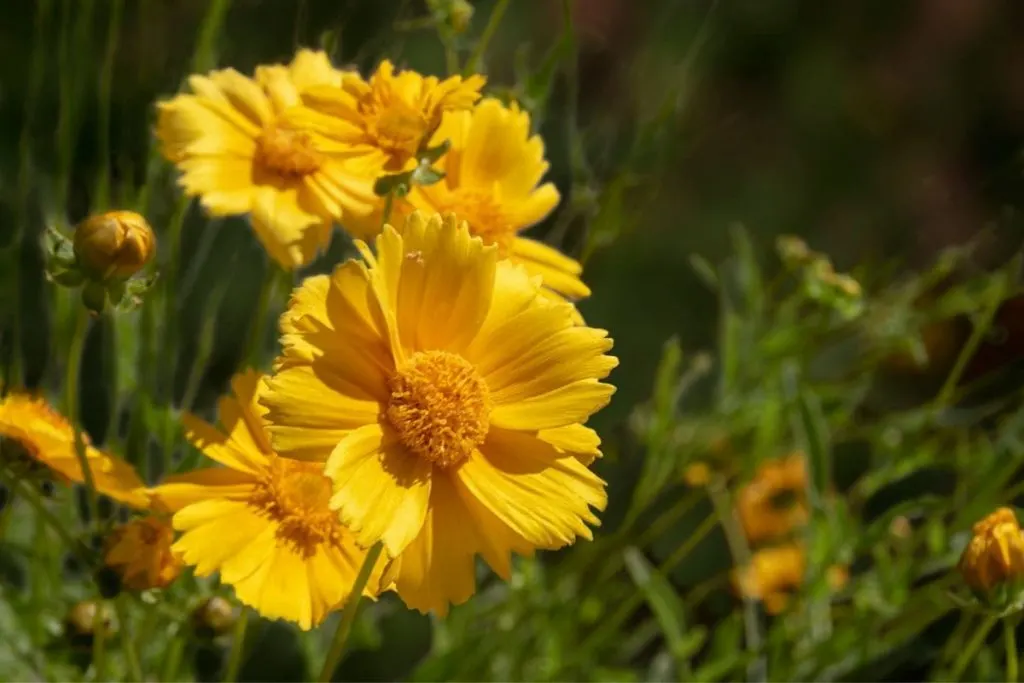
Baileya multiradiata is a perennial you’ll fall in love with. Coming from an Asteraceae family it will be your favorite yellow plant in the garden.
It reaches around 30 inches of height when taken care of correctly. It’s native to northern Mexico and known for its oily flowers. It grows well in hardy zones 7-10.
Light needs
When choosing the best location for it, go with a location that has lots of morning sun and bright indirect light in the afternoon. Full shade is a big no for this plant.
Water needs
Water it every 7 days for the best growth ratio, especially in its blooming time which is early to late spring. The type of water doesn’t matter much.
Soil type
It grows best in well-draining, rocky soil. Avoid acidic soils for desert marigold plants.
Humidity
Between 40 and 50% of humidity levels.
Fertilizer
This plant doesn’t have to be fertilized.
Propagation
The easiest propagation you can perform on this plant is through seeds. Place the seeds in well-draining soil in a sunny location and expect growth in about 3-4 weeks.
11. Foxglove
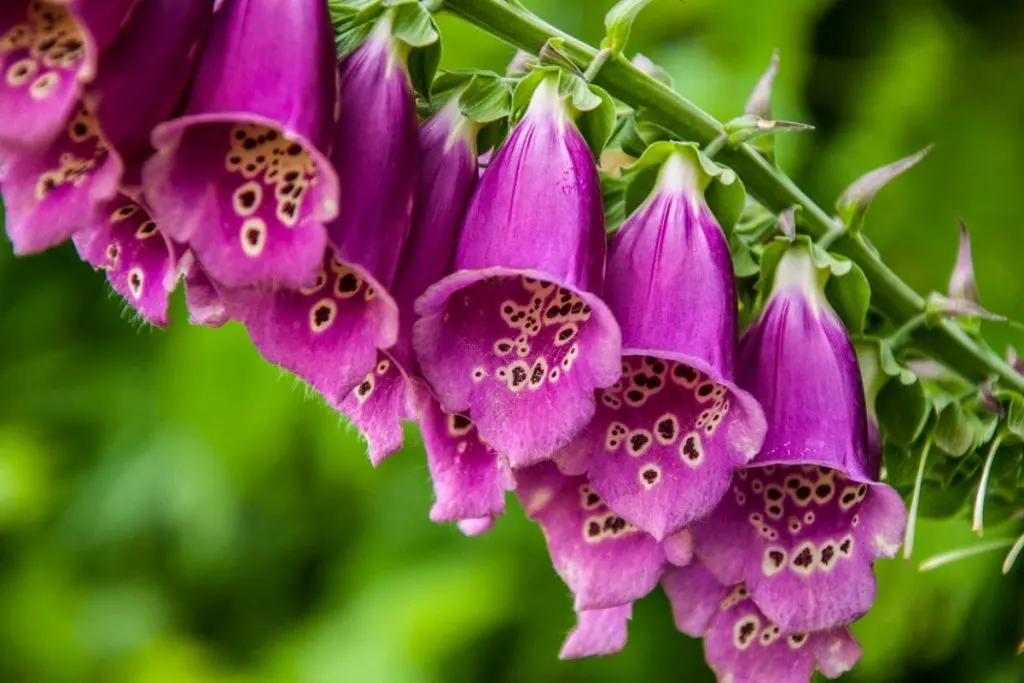
Digitalis is a plant well–known for its vibrant purple flower clusters shaped like tubas. They originate from Plantaginaceae family and they’re native to Mexico.
However, even though the plant is very beautiful, it’s toxic, and touching it can cause allergic reactions. It can cause throat swelling, breathing difficulties, and stomach irritation.
Light needs
It is best to plant it in a location where it gets direct sun in the morning and light shade in the afternoon. Flowers are very sensitive, so more than 3 hours of sun can damage the petals.
Water needs
Water the foxglove plant once every 8 days, and during flowering, water a little up to every 5 days. When it blooms, reduce watering again.
Soil type
Any soil type will work for the foxglove plant as long as they’re well-draining.
Humidity
Humidity levels should be around 50% for the foxglove plant.
Fertilizer
Fertilize it once a month to maintain a nutrient-rich fertilizer such as 10-15-10 fertilizer.
Propagation
Propagate your foxglove plant with seeds, which is the easiest and most effective way for foxglove plants.
FAQs on the plants for Arizona

Below we will answer the most popular questions about low-maintenance Arizona plants, so let’s check them out. We didn’t miss any info yet, right?
What are drought-tolerant plants for Arizona?
What is the best evergreen shrub in Arizona gardens?
Final Thought On Low Maintenance Plants For Arizona
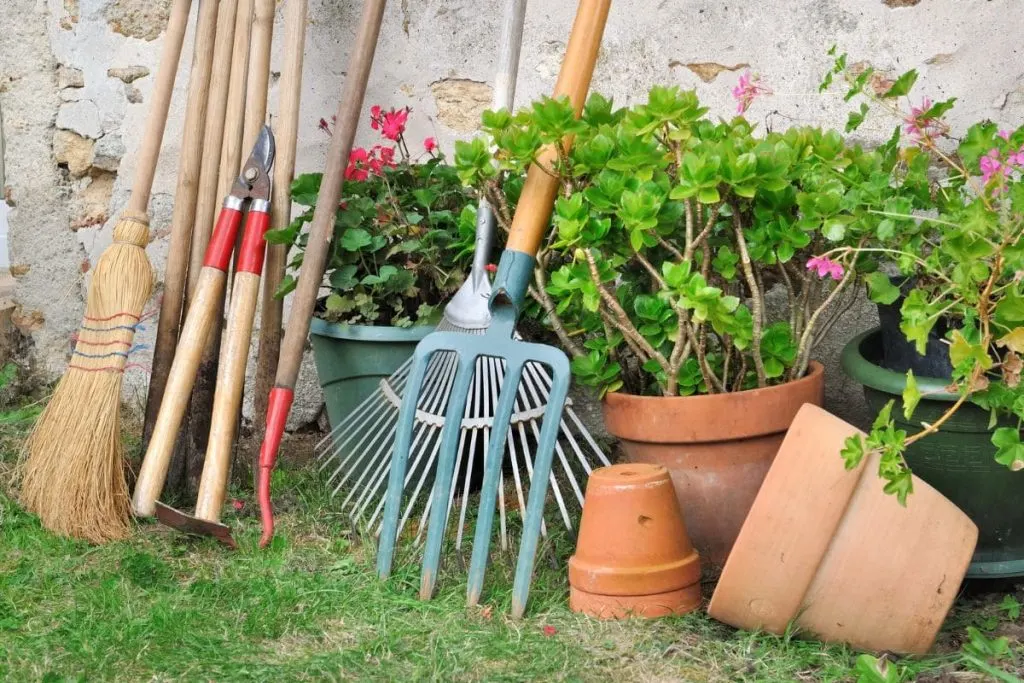
I sincerely hope you learned everything you wanted to learn about the low-maintenance plants for Arizona in our article.
Just imagine fine-textured foliage, annual plants, and perennial plants that attract hummingbirds in your garden next spring.
Those are all low-maintenance plants and evergreen plants. Tiny green leaves, colorful flowers, feathery foliage, fuzzy red berries, feathery needle-like leaves, just wow, the choice is endless.
If you are ready for a tall plant or a small tree that doesn’t need much care at all, make sure you listen to our advice and grow some of these plants above, you won’t be disappointed I’m sure.
Enjoy your beautiful plants, that would be all for today, see you tomorrow with similar topics.

